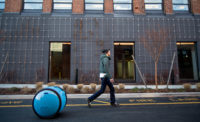No single tool has become more critical to architectural practice than the computer. In fewer than 30 years, CAD software and related products have become an entire industry by catering to the needs of designers. But the early years of architects’ use of digital tools are little known. Greg Lynn, founder of Greg Lynn FORM and a professor at UCLA, has curated exhibitions that explore this early architectural experimentation. The exhibition, the second of three on this theme, Archaeology of the Digital: Media and Machines, originally at the Canadian Centre for Architecture, is now at the Yale School of Architecture (through May 1, 2015), where Lynn is the Davenport Visiting Professor.
What spurred you to conduct an Archaeology of the Digital?
The exhibitions are part of an archival project at the CCA. It started years ago when they acquired my Embryological House project, with its physical and digital material. That prompted a discussion of what their policy on digital material should be—the scope of their efforts and how to save the material. Another big part of the exhibition is interviews with the architects, collaborators, and technologists, to build an oral history. It’s too early to write the history of digital architecture, but without this information, nobody can.
So the exhibition contains some unconventional architectural material?
We included a lot of interactive mechanical elements that people won’t be used to seeing. For example, there’s ONL’s NSA Muscle hanging on the wall, pumping away when visitors walk up to it. The HypoSurface by dECOi Architects isn’t interactive, but it’s exciting to see that big robotic wall moving. Along with Karl Chu’s Catastrophe Machine, these are robots that change the space and make things dynamic.
What stands out in this period of early experimentation, now 20 years old?
For me, what was amazing was how people were looking to the computer for formal or fabrication possibilities even as others looked for an architectural response to large-scale media and interactivity. For whatever reason, most architectural interest in digital technology then shifted to fabrication. Now everyone’s looking to smart and interactive environments. Google and Amazon have picked up a lot of the interests of this exhibition’s architects. If somebody had spent the last 15 years working on those interests, they would be insanely successful right now. A lot of the architects’ collaborators ended up pivoting toward apps and the Web.
What will different generations see in this exhibition?
The projects, and the period they come from, are probably unknown to most. We received a lot of custom software and machines for interfaces from these architects. It’s remarkable to see that, even 30 years ago, architects were already developing technology in-house. The myth is that architects just use or misuse software, but the reality is that certain architects were the ones who developed the technology. There was no off-the-shelf architecture software back then; it was very bespoke.
So much of what enabled the projects is ephemeral: programs and scripts that have been lost or can’t be read by most of today’s computers. Did curating these projects present special challenges?
The first exhibition was interesting because a lot of people associate the advent of digital technology with people of my generation but it was really two generations ahead of us. That older material was the most fragile, un-openable, and a lot of it had disappeared. It’s a huge challenge.
There’s an ongoing conversation about how we let digital tools shape architectural designs. You’ve been a part of that debate from its beginnings, writing about biomorphic architecture and using calculus in designing your architecture. Does this exhibition offer some perspective on that discussion?
In the 80s there was a rich culture of intellectual exchange between historians, writers, intellectuals, outside the architecture field. It was an amazing time, and digital technology entered into that whole dialogue and really took center stage. Theorists, historians, practitioners became very interested in the computer. And then the whole bottom dropped out, and I don’t know exactly why. Theorists retreated into histories of postwar modernism and stopped speculating on contemporary work. Architects stopped talking to cultural and intellectual audiences. They just started to have shoptalk about fabrication. It became very vocational. What I’m hoping for with these shows is to provoke a new generation to reengage with that material. Most historians were trained in, at least, perspective, plans, and section. They had a working knowledge of the tools, so they could write a history of it. Most historians aren’t trained in these digital tools, and they have to resort to platitudes or retreat from the discussion.
You’re currently working in an experimental robotics studio. Is that what’s next for you?
It is. I would credit the CCA with reigniting my interest in robotics: not just for manufacturing, but for building dynamic spaces. At UCLA we’ve got a new facility with the ability to move around walls and floors and large-scale things like that. It really came out of looking at this period.















Post a comment to this article
Report Abusive Comment